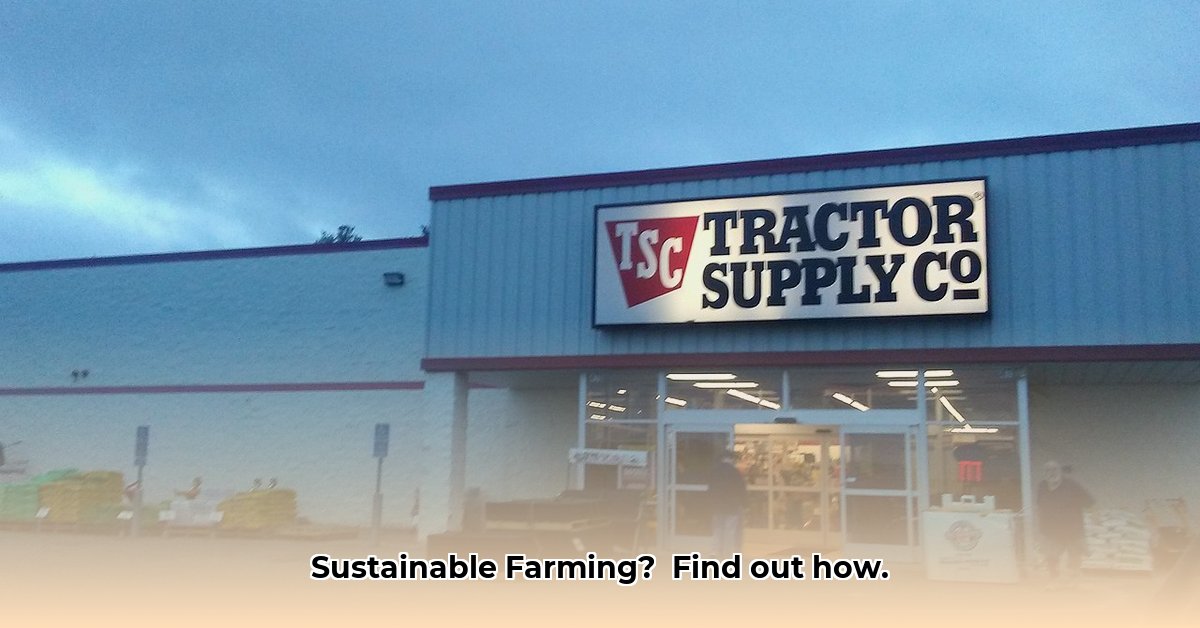
What North Windham Tractor Supply Offers: A Convenient, but Unclear, Resource
North Windham Tractor Supply provides a wide array of products crucial to local agricultural operations. From seeds and tools for small gardens to heavy-duty equipment for larger farms, the store acts as a one-stop shop for many farmers and gardeners. Their offerings encompass fertilizers, pest control solutions, animal feed, fencing materials, and various tools for land management. However, the convenience of this centralized resource needs further scrutiny when examining its commitment to sustainable practices. The readily available product list alone does not provide a full picture of the store's environmental impact. For weed control solutions, check out helpful resources like this guide.
The Sustainability Gap: Transparency’s Absence Hinders Evaluation
While Tractor Supply offers products relevant to sustainable farming, a significant obstacle to evaluating its overall impact is the notable lack of transparency surrounding its sustainability efforts. Crucial data remains unavailable, preventing a comprehensive assessment of the environmental consequences linked to its operations. Several key questions remain unanswered: Where are Tractor Supply's products sourced? What are the manufacturing processes involved? How environmentally friendly are the packaging materials? And what is the carbon footprint of delivering these goods? This lack of information hinders a complete and honest analysis.
For example, the type of fertilizers offered—organic or conventional—directly influences the long-term environmental effects on soil health and water quality. Similar uncertainty surrounds the sourcing of animal feed and its potential impact on the local ecosystem. The transportation of goods constitutes another critical area lacking explicit information. The absence of data on emissions from the delivery system leaves a considerable gap in understanding the overall environmental impact of this essential retail outlet. Similarly, information on packaging materials—their recyclability and sustainability—was also unavailable, making it difficult to assess this aspect of its sustainability performance. How can we accurately assess environmental responsibility when such fundamental details remain undisclosed?
Stakeholder Perspectives: Shared Responsibility, Shared Action
Building a genuinely sustainable agricultural ecosystem in North Windham demands a collaborative effort involving multiple stakeholders. Each group bears responsibility for fostering change.
| Stakeholder | Short-Term Actions | Long-Term Actions |
|---|---|---|
| Tractor Supply Co. | Publicly disclose product sourcing, manufacturing, and packaging information. | Develop a comprehensive sustainability plan, including detailed lifecycle assessments of its product lines, and publicly report its environmental footprint. |
| Local Farmers/Gardeners | Prioritize sustainable product choices when possible. | Advocate for greater transparency and more sustainable options from Tractor Supply and other agricultural suppliers. |
| Consumers | Educate themselves on sustainable agriculture and make informed purchasing choices. | Actively support businesses demonstrably committed to environmental responsibility. |
| Local Government | Collaborate with Tractor Supply and farmers to promote sustainable initiatives. | Implement policies incentivizing sustainable farming practices, such as tax breaks or grants for farmers adopting eco-friendly methods. |
Risk Assessment & Regulatory Implications: Potential Pitfalls and Compliance
Unsustainable agricultural practices pose significant risks to the environment. The utilization of conventional fertilizers, pesticides, and unsustainable livestock feed practices can have long-term detrimental effects on land, water, and air quality.
| Technology/Practice | Risk Level | Mitigation Strategies |
|---|---|---|
| Conventional Fertilizers | High | Transition to organic fertilizers; implement soil testing for precision fertilizer application. |
| Pesticide Use | High | Employ Integrated Pest Management (IPM); explore biological pest control methods; minimize chemical pesticide usage. |
| Livestock Feed Sourcing | Medium to High | Prioritize locally sourced, sustainable feed; ensure responsible grazing practices; reduce reliance on imported soy. |
| Packaging | Low to Medium | Increase the use of recycled and biodegradable packaging; minimize packaging materials overall. |
| Transportation (Delivery) | Medium | Optimize delivery routes; explore alternative fuels; encourage local sourcing to reduce transportation needs. |
Adherence to environmental regulations is non-negotiable for Tractor Supply. Failure to comply can result in significant fines and reputational damage. Stronger governmental oversight and enforcement are vital.
Conclusion: A Call for Transparency and Continuous Improvement
Tractor Supply's role in supporting sustainable agriculture in North Windham remains a complex issue. While the store provides essential resources, critical information gaps exist, highlighting the need for improved transparency and concrete actions to promote environmentally sound practices. Further research is crucial to fill these data gaps and gain a clearer understanding of Tractor Supply’s true impact. The sustainability of local agriculture requires a collective commitment from all stakeholders, prioritizing not just economic growth but the long-term environmental health of the community.